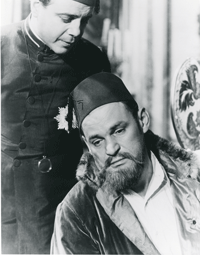Abdul the Damned
(GB 1934/35)

Inhalt
Abdul Hamid, auch der »rote Sultan« genannt, führt ein despotisches und grausames Regiment. Der Versuch, mit dem aus dem Exil zurückgerufenen Führer der »Jungtürken« eine demokratische Regierung zu bilden, scheitert an Intrigen und Machtkämpfen. Getarnt mit einem weißen Fes, dem Erkennungszeichen der Jungtürken, tötet Abdul Hamids Polizeichef Kadar Pasha im Auftrag des Sultans den Anführer der Alttürken. Doch es gibt einen Zeugen, Talak Pasha. Die wiener Schauspielerin Therese Alder erklärt sich bereit, in den Harem des Sultans einzutreten, wenn dieser Talaks Leben verschont. Talak wird freigelassen und schließt sich den Rebellen an, die einen großen Aufstand gegen den Sultan vorbereiten, um dessen Herrschaft endgültig zu beenden.
Zur Produktion
Der [englische] Film, der in seiner allegorischen Darstellung des Nazismus am deutlichsten wird, dürfte Karl Grunes ABDUL THE DAMNED (1934/35) sein. […] Mag die Geschichte vom Aufstand der Jungtürken auch im Jahre 1908 spielen – der von Fritz Kortner gespielte Abdul wirkt wie eine allegorische Darstellung Hitlers, das Massaker an den Jungtürken erinnert an die Ermordung Ernst Röhms und seiner SA-Führer durch Mitglieder der SS im Jahre 1934. Als das Drehbuch – noch unter dem Titel »Abdul Hamid« – dem BBFC vorgelegt wurde, beschäftigte sich die Zensur allerdings ausschließlich mit der Darstellung jener Ereignisse, die mehr als zwanzig Jahre zurücklagen. Als der fertige Film im Februar 1935 geprüft wurde, zog man vor der Freigabe Mitglieder des Auswärtigen Amtes zu Rate, um festzustellen, ob der Film die Türkei beleidigen könne.
Richard Falcon: No Politics!
In: Jörg Schöning (Red): London Calling. München: edition text + kritik 1993, S. 87-88.
Kritiken
ABDUL THE DAMNED is an intense thriller. It has novelty, a picturesque setting, and is particularly interesting. Based on historical events belonging to the Gladstone era, it nevertheless has some relationship to present-day affairs. Rarely have fact and fiction been better blend on the screen. It is a convincing and careful story, with some flair.
We must not inquire why an Austrian actress should find it so easy to make herself understood in Turkey. Linguistic difficulties are constantly evident in pictures, and the problem may never be solved till we all speak Esperanto. We can mix the nationalities, but the mixing of tongues is usually comic. Perhaps some over ingenious producer will one day, after the fashion of Eugene O’Neill, introduce an interpreter-commentator whose business it will be to act as a living speaker of captions. It will hold up the action but provide a diversion.
Fritz Kortner is the one man in all the world for Abdul. Not one gesture, one inflection, one twist of expression is he capable of making that is not supremely suited to the character. He portrays a sinister, much to be hated, more to be pitied, malignant monster. As a study of vileness, it is immense. Whether or no it is a faithfull portrait of one of the ugliest tyrants in history I can’t say. Here is a fascinating psychological study set in a drama as entertaining as it is new. The settings are splendid, ornate. The photography is excellent. Groupings and crowds handled efficiently.
Adrienne Ames exactly fits the role of a Victorian theatrical Beauty and gives an admirable performance. Is she, however, quit the voluptuous type usually associated with Sultanic desire? Esme Percy stands out finely in an excellent cast, which includes Nils Ashter, suave and menacing as Chief of Police, and Charles Carson as the fervent and conscience-driven loader of the Home Turk Party.
Abdul the Damned
The Sunday Times (London), 3.3.1935
The imperturbable Rialto Theatre imposes a strain on its architecture this week by striving to keep a straight facade even while offering two such strange screen bedfellows as the Canzoneri-McLarnin fight pictures and ABDUL THE DAMNED, a semi-historical chapter on the wife and crimes of Abdul Hamid II, Sultan of Turkey from 1876 to 1909. Although the film achieves a few moments of dramatic interest – chiefly through the performance of the Continental Fritz Kortner – it is in the main a tedious and uninspired biography, scarred by hypodermic injections of stale melodrama.
The late Abdul Hamid, as the Armenians have cause to remember, was one of the last pre-war absolute despots. He lived in terror for his life, and his subjects lived in terror for theirs. It is recorded of him that he never slept twice in succession in the same room, such was his fear of assassination. His spies were more active and numerous and deadly than Russia’s Cheka. And finally (in April, 1909) there was a revolt, led by the Young Turks, and Abdul the Damned became a palace prisoner and so remained until his death in 1918.
Mr. Kortner’s portrayal of the cruel, scheming and fear-ridden monarch has the proper depth and shading, but the portrait loses its significance through being placed in a tawdry gallery of stock heroics. The English producers, apparently unwilling to confine themselves to such undramatic matters as massacre, intrigue, rebellion and murder, have attempted to leaven the dull pages of Turkish history with a glamorous plot concerning the Sultan's admiration for a Viennese actress. By threatening the man she loves he forces her to enter his harem and that situation is made the pivotal point upon which Abdul's fortunes turned.
While there is no strong objection to a romantic sub-plot, it does seem that the film-makers might have kept a sense of proportion. By treating Miss Adrienne Ames's entrance into the seraglio with as much concern as they recorded the revolt of the Turks and the collapse of the despot, they have deprived the picture of any right to be considered seriously. Similarly, having no dramatic honesty, the film moves with the ridiculous solemnity of a processional at which mischievous small boys are tossing firecrackers. Mr. Kortner is its only asset.
Frank S. Nugent: Abdul the Damned
The New York Times, 11.5.1935